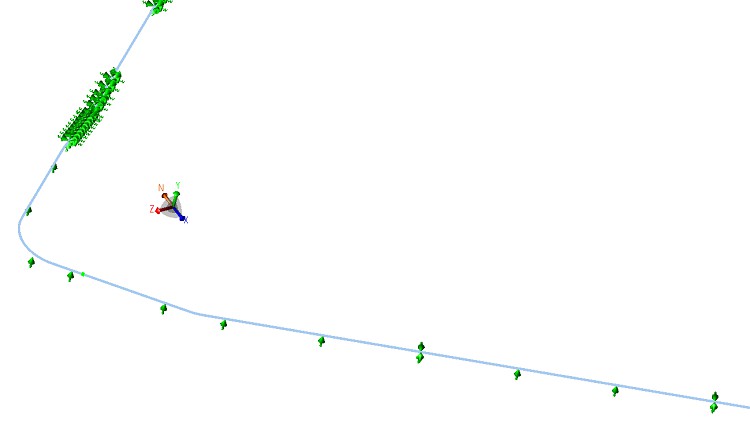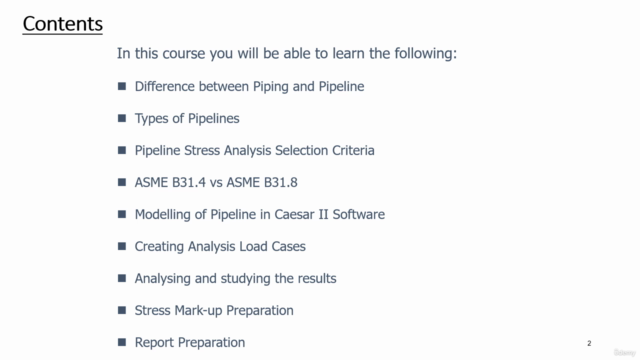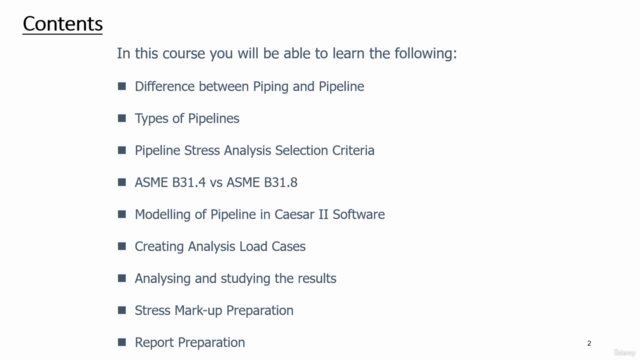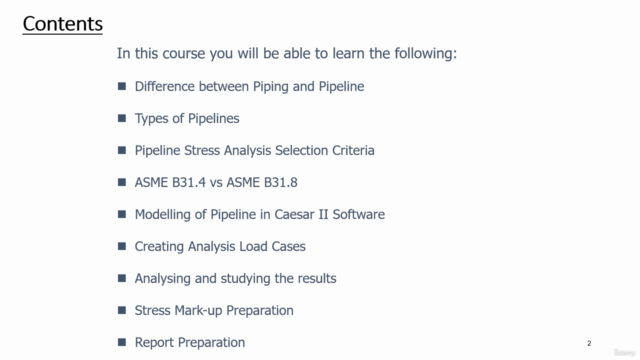Modeling and Analysis of a Pipeline in Caesar II

Why take this course?
🛣️ Master Pipeline Stress Analysis with Confidence!
🚀 Course Title: Pipeline Stress Analysis using Caesar II
🎉 Headline: Dive into the World of Pipeline Stress Analysis - A Comprehensive Course Using ASME B31.8/ASME B31.4 with Caesar II!
Course Overview: This meticulously crafted course is your ultimate guide to mastering pipeline stress analysis using the powerful Caesar II software, tailored for engineers in the field of piping systems. Whether you're new to pipeline analysis or looking to sharpen your skills, this course will equip you with a deep understanding of the principles and practical applications necessary to ensure the safety and integrity of pipelines under various operating conditions.
Key Learnings:
-
Understanding Piping vs. Pipeline: Grasp the fundamental differences between traditional piping systems and large-diameter transmission pipelines.
-
Types of Pipelines: Explore the diverse landscape of water, oil, and natural gas pipelines, understanding their unique demands and challenges.
-
Selection Criteria for Stress Analysis: Learn the criteria that guide the choice of analysis method for different types of pipeline systems.
-
ASME B31.4 vs. ASME B31.8: Uncover the major differences between the ASME B31.4 liquid pipeline code and the ASME B31.8 gas pipeline codes, ensuring compliance with industry standards.
-
Modeling in Caesar II Software: Follow a step-by-step approach to accurately model pipeline systems for analysis within Caesar II.
-
Creating Analysis Load Cases: Master the art of generating essential load cases tailored to the specific requirements of your pipeline system analysis.
-
Analyzing Results: Study the Caesar II results to ascertain whether the pipeline system is stress-acceptable and ready for service.
-
Stress Mark-up and Report Preparation: Learn how to effectively mark up changes in the design and prepare comprehensive reports that meet industry standards.
Course Structure: The course is segmented into logical modules, each designed to build upon the previous one, culminating in a practical case study that brings together all the learned concepts in a real-world scenario.
-
Introduction to Pipeline Systems and Caesar II Software
-
Differences Between Traditional Piping and Pipelines
-
Understanding ASME B31.4 and ASME B31.8 Codes
-
Detailed Steps for Modeling in Caesar II
-
Generating Analysis Load Cases
-
Interpreting and Analyzing Results
-
Stress Mark-up Techniques and Report Writing
Practical Application: Throughout the course, you'll engage with a detailed practical case study that simulates an actual engineering job. This will take you through:
-
Modeling Steps: Learn the exact steps required to model a pipeline system for analysis.
-
Error Checking: Understand how to effectively check your work for accuracy and completeness.
-
Load Case Creation: Discover how to create the necessary load cases for a comprehensive analysis.
-
Reviewing Caesar II Output Results: Gain insights into how to evaluate the results generated by Caesar II.
Course Highlights:
- Step-by-step guidance from the basics to advanced concepts.
- Practical, hands-on experience with a real case study.
- Comprehensive understanding of pipeline alignment sheets and 3D analysis models.
- Insight into selecting support types and locations.
- A thorough grasp of code requirements for both ASME B31.4 and ASME B31.8.
- Knowledge on how to finalize design drawings and reports.
Embark on this journey to become an expert in pipeline stress analysis, ensuring the safety and efficiency of pipelines around the globe. Enroll now and transform your career with the power of Caesar II and the wisdom of industry-standard practices! 🛠️💧🚀
Course Gallery




Loading charts...